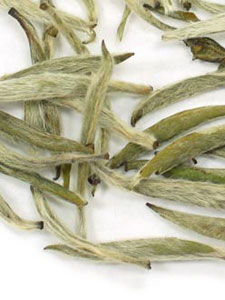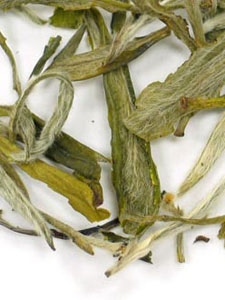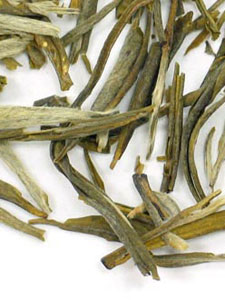Everything You Need to Know about White Tea



When Song Dynasty emperor Hui Zhong proclaimed white tea to be the culmination of all that is elegant, he set in motion the evolution of an enchanting variety. For centuries white tea has been shrouded in obscurity outside of China, but today its much-beloved qualities are being discovered by tea lovers around the world. Equally as stunning dry as it is steeped in water, white tea presents an exquisite range of flavor and aroma, from a delicate sweetness to a more pronounced brightness. Here's its interesting story.
A form of compressed tea referred to as white tea was being produced as far back as the Tang Dynasty (618-907 A.D.). At this time in tea's history, the nature of the beverage and style of tea preparation were quite different from the way we experience tea today. Tea leaves were processed into cakes and prepared by boiling pieces of the compressed tea in earthenware kettles. This special white tea of Tang was picked in early spring when the new growths of tea bushes that resemble silver needles were abundant. These "first flushes" were used as the raw material to make the compressed tea.
During the Song Dynasty (960-1279), production and preparation of all tea changed. The tea of Song included many loose-leaf styles (to preserve the delicate character favored by the court society), but a new powdered form of tea emerged. Tea leaves were picked and quickly steamed to preserve their color and fresh character. After steaming, the leaves were dried. The finished tea was then ground into fine powders that were whisked in wide bowls. The resulting beverage was highly regarded for its deep emerald or iridescent white appearance and its rejuvenating and healthy energy.
This Song style of tea preparation incorporated powdered tea and ceramic ware in a ceremonial aesthetic known as the Song tea ceremony. Japanese monks traveling to China at this time had learned the Song preparation and brought it home with them. Although it later became extinct in China, this Song style of tea evolved into the Japanese tea ceremony, which endures today.
Many forms of white tea were made in the Song Dynasty due to the discerning tastes of the court society. Hui Zhong, who ruled China from 1101-1125, referred to white tea as the best type of tea, and he has been credited with the development of many white teas in the Song Dynasty, including "Palace Jade Sprout" and "Silver Silk Water Sprout."
Producing white teas was extremely labor-intensive. First, tea was picked from selected varietals of cultivated bushes or wild tea trees in early spring. The tea was immediately steamed, and the buds were then selected and stripped of their outer, unopened leaf. Only the delicate interior of the bud was reserved to be rinsed with spring water and dried. This process produced white teas that were paper thin and small.
Once processed, the finished tea was distributed and often given as a tribute to the Song court in loose form. It was then ground to a fine, silvery-white powder that was whisked in the wide ceramic bowls used in the Song tea ceremony. These white powder teas were also used in the famous whisked tea competitions of that era.
After the transition from compressed tea to the powdered form, the production of tea for trade and distribution changed once again. In 1391, the Ming court issued a decree that only loose tea would be accepted as a "tribute." As a result, loose tea production increased and processing techniques advanced. Soon, most tea was distributed in full-leaf, loose form and steeped in earthenware vessels.
White Teas Today Modern-day white teas can be traced to the Qing Dynasty in 1796. Back then, teas were processed and distributed as loose tea that was to be steeped, and they were produced from "chaicha," a mixed-variety tea bush. They differed from other China green teas in that the white tea process did not incorporate de-enzyming by steaming or pan-firing, and the leaves were shaped. The silver needle white teas that were produced from the "chaicha" tea bushes were thin, small and did not have much silvery-white hair.
It wasn't until 1885 that specific varietals of tea bushes were selected to make "Silver Needles" and other white teas. The large, fleshy buds of the "Big White," "Small White" and "Narcissus" tea bushes were selected to make white teas and are still used today as the raw material for the production of white tea. By 1891, the large, silvery-white down-covered Silver Needle was exported, and the production of White Peony started around 1922.
According to the different standards of picking and selecting, white teas can be classified as Yin Zhen Bai Hao (Silver Needle), Bai Mu Dan (White Peony), Gongmei (Tribute Eyebrow), and Shou Mei (Noble, Long Life Eyebrow). All of these white teas are widely produced in China and are available in America.
The highest-quality white teas are Silver Needle and White Peony, both of which have various grades and are primarily produced in the Fuding and Zhenhe districts of Fujian, China. Silver Needle is carefully hand selected from the tender fleshy sprouts of the "Big White" tea bush or the " Narcissus" bush. If the buds are selected with two leaves intact, then the resulting selection will be made into White Peony tea. The leaves and other material left over from the selection of Silver Needle and White Peony will be processed into Noble, Long Life Eyebrow. Gong Mei is made from "chaicha" bushes and is processed slightly differently than other white teas. Both Gong Mei and Shou Mei are considered lesser forms of white tea compared to Yin Zhen Bai Hao and Bai Mu Dan.
Evaluating Quality "Three Whites" is the primary requirement of the fresh tea material. This means the buds, the first leaves and the second leaves must be covered with tiny white hairs. Be warned that a tea with an abundance of white tips or large buds is not necessarily a true white tea.
The quality of white tea is greatly dependent on the season of harvesting. The best white tea is picked in early spring and is subject to numerous requirements. First of all, picking top-grade white tea is prohibited on rainy days or when the early morning dew is not dry. It should never be picked when the buds appear purple; when they are damaged by wind, people, or insects; when they have begun to open; when they are hollow; when they are too long or too thin; when there is one bud with three to four leaves; and when there is frost on the ground.
The highest grade of the finished Silver Needle white tea should be fleshy, bright colored and covered with tiny white hairs. The shape should be very uniform, with no stems or leaves. The flavor and fragrance should be delicate, light, fresh, and slightly sweet. The liquor should be a glittering pale yellow color with evidence of floating white hairs that reflect light.
The highest grade of finished White Peony white tea should appear as two intact grayish green leaves and a silvery bud. The two leaves and bud should be covered with a fine, silvery-white down. The bud and two leaves should adhere to the stem and should be uniform and virtually unbroken. This grade is extremely rare in America. The finest quality should have a shimmering clear infusion with a delicate lingering fragrance and a fresh, mellow, sweet taste devoid of astringency and grassy flavors.
Most White Peony in America yields a darker infusion, a nutty or bamboo fragrance, and a sweet and slightly smoky taste. These teas are not very high grades in China, but their more obvious character is widely appreciated in America and Europe and is more suitable for foodservice because they are less delicate and have a more pronounced flavor and fragrance.
Modern Production Due to tea's ancient history and its evolving processing techniques, there has been confusion about how white teas are produced today. Modern-day white teas are not steamed. Their process relies on withering, careful hand selection and bake drying. The special nature of white tea's color, leaf shape and hair fragrance is mainly created during the withering stage.
White tea production is greatly dependent on the weather conditions when the tea is made. Adjustments to the withering stage and the method of bake drying will be determined by tea makers as they interpret the effect the weather will have on the withering process. Temperature and humidity of the environment will dictate the techniques and timing of the withering and bake drying process. White tea that is withered in conditions that are too hot will become reddish, while leaves that are withered in conditions that are too cold will become blackish.
A tea maker's ability to balance solar and indoor withering of white tea is the major determining factor of quality. There are many nuances of white tea production that are dependent on the region and climate where the tea is made, but the major stages in the process are selective picking from specific varietals, withering, careful hand selection, and bake drying.
The Perfect Cup White teas are best when prepared like green tea. Their delicate nature will be destroyed by water that is too hard or too hot. Filtered water or spring water that is not too heavy will produce the best cup. Water that is too hot will cook the delicate leaves and render an inferior-tasting, astringent cup. The ideal water temperature is between 175 and 180 degrees Fahrenheit. Add 1 to 1.5 tablespoons of white tea per eight ounces of water in a cup or teapot. Pour water over the tea and steep for two minutes.
One serving of white tea can be brewed several times, with each steep revealing another element of flavor. In the case of Silver Needle, the steeping can be as long as three to four minutes, depending on the water temperature. Some drinkers like to steep Silver Needle with cooler water for longer times. This will increase the stockiness of the tea infusion, but it will also yield a less fragrant and lingering cup of tea. Experiment with these methods to find your perfect cup of white tea.
